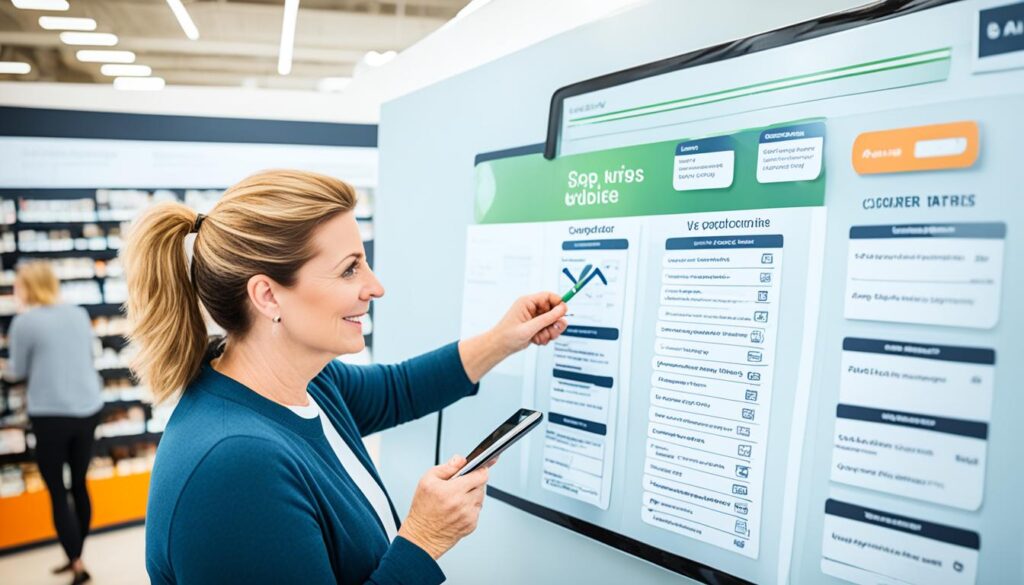
In the digital marketing world, making one sale is just the start. The real trick is turning buyers into fans who love your brand. This brings long-lasting success to businesses.
Lifecycle marketing is about knowing the steps customers take and guiding them at every step. This journey starts from the first time they hear about you and goes beyond the sale. Every step is a chance to make a loyal customer out of them.
To pull this off, digital pros need top skills in web analytics, social media marketing, email marketing, and more. These tricks help follow and excite customers as they move through the journey. Using personal touches and focusing on what the customer wants helps in creating strong ties. These ties bring business growth and loyalty.
Key Takeaways:
- Knowing the user journey well is key to lasting success.
- Helping and guiding customers at every journey step is what lifecycle marketing is about.
- Being great at web analytics and online marketing is crucial to keeping customers interested.
- Using personal approaches and caring about the customer builds strong relationships.
- Effective lifecycle marketing leads to business growth and loyalty.
The Five Crucial Stages of the Customer Lifecycle
The customer lifecycle is made up of five key stages. These stages help guide customers' journeys and let businesses foster their relationships. They start with awareness and then move through consideration, conversion, retention, and advocacy.
Awareness Stage
The first stage is about catching the eye of potential customers. It's done through social media efforts, online ads, creating content, and ensuring your website is easily found. When you target your audience smartly and share compelling messages, your brand becomes more visible, thus raising awareness.
Consideration Stage
In the second stage, customers look at what you offer and how it stacks up against others. It’s key to show why your products or services stand out. Using personalized marketing and making it easy to buy from you can help sway their decision.
Conversion Stage
Stage three is about turning those considering into actual buyers. Email marketing and ads can help convince customers of your product’s or service’s value. Tracking their online movements and behavior helps improve this stage over time.
Retention Stage
Keeping customers coming back is crucial. This stage is all about staying in touch personally, offering rewards, and great service. With special and memorable actions, companies build strong bonds with their clients.
Advocacy Stage
The final stage aims to turn happy customers into fans who promote your brand. By encouraging word-of-mouth, sharing user-generated content, and building a community, you can boost customer advocacy. Making experiences personal will strengthen this advocacy even more.

It's essential for businesses to understand and act on each stage of the customer lifecycle. Doing so improves customer interaction and loyalty, driving up sales and advocacy for your brand. Coming up, we'll check out some powerful personalized marketing approaches for the customer lifecycle stages.
Conclusion
Knowing the customer lifecycle and using the right marketing steps are crucial for any business to thrive. By understanding how customers move from being interested to staying loyal, businesses can grow. They do this by targeting their marketing to each step, ensuring their efforts are well-measured and customer-focused.
Tools like web analytics can guide businesses in tweaking their marketing for triumph in the long run. By studying what customers like and want, companies can make experiences that truly speak to their audience. This attention to detail makes customers feel special and boosts their loyalty, turning them into the brand's cheerleaders.
By fully embracing customer lifecycle marketing, brands can see significant growth and support from their customers. It's about a journey towards capturing your customers' hearts and minds. So, is your business ready for this exciting challenge and the promise of marketing that truly works?
FAQ
What is customer lifecycle marketing?
Customer lifecycle marketing means getting to know and support customers all through their journey with you. It aims to hook potential buyers, turn them into steady customers, and even into loud cheerleaders for your brand.
What are the five stages of the customer lifecycle?
The five stages are awareness, consideration, conversion, retention, and advocacy. Each step is a chance for companies to connect and grow with their customers.
How can I capture the attention of potential customers?
To catch potential buyers' eyes, dive into social media, online ads, great content, and SEO. These tactics help get your brand noticed and stir up interest.
How can I enhance the consideration stage?
For the *consideration* stage, share everything about your product, use one-on-one marketing, and make buying easy. This way, potential customers can really see what you offer and pick you over others.
How can I turn potential customers into active buyers?
Use email campaigns and ads to move potential customers from window-shopping to buying. These methods encourage them to choose your product and take the plunge.
How can I keep customers engaged and build loyalty?
To keep customers interested and loyal, focus on personal touch, offer rewards, and provide standout service. Making their experience great keeps them coming back.
How can I turn satisfied customers into brand advocates?
For turning happy customers into cheerleaders, ask for referrals, share user posts, and connect with fans. This builds a group of advocates who love spreading the word about you.
Why is understanding the customer lifecycle important for businesses?
Knowing the customer's journey and using the right marketing actions is key to success. It helps companies grow, keep customers, and see how well their ads work.
How can businesses measure the effectiveness of their marketing efforts?
Companies should use web analytics and similar tools to check their ads. This helps grow their campaigns and gives insights on what customers like.
Why is personalized communication important in the customer lifecycle?
Personal chat is key because it makes customers feel understood. Sending messages that meet their needs makes the experience much better.
How can businesses build lasting connections with customers?
For strong ties, companies should focus on what the customer wants. This means giving personal experiences, talking meaningfully, and always adding value.











